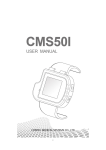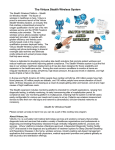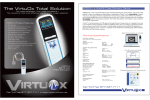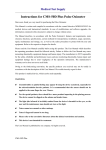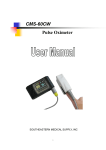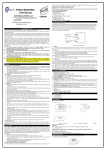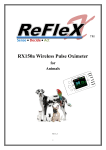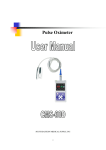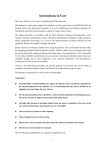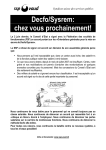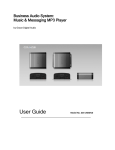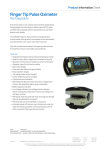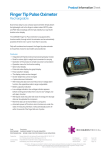Download VPOD Ultra Manual
Transcript
VPOD Ultra USER INSTRUCTIONS Thank you for purchasing the VPod Ultra Series Wrist Pulse Oximeter. This manual is written and compiled in accordance with council directive MDD93/42/EEC for medical devices and harmonized standards. In case of modifications and software upgrades, the information contained in this document is subject to change without notice. For the most up to date manual please visit www.VirtuOx.net , click on products and choose VPOD Ultra. The manual describes, in accordance with the Pulse Oximeters features and requirements, main structure, functions, specifications, correct methods for transportation, installation, usage, operation, repair, maintenance and storage, etc. It also includes safety procedures to protect both the user and the equipment. Refer to the respective chapters for details. Please read the m anual carefully before using this product. The section describing operating procedures should be followed carefully. Failure to follow the instructions given may cause measuring abnormality, equipment damage and human injury. The manufacturer is NOT responsible for the safety, reliability and performance issues and any monitoring abnormality, human injury and equipment damage due to users' negligence, through improper use or operation contrary to these written instructions. The manufacturer’s warranty is Null and Void under these circumstances as well. . WARNING: M Discomfort or pain may appear if using the device continuously for longer than specified periods of time, especially with microcirculation barrier patients. M For the special patients, there should be a more prudent inspecting in the placing process. The device can not be clipped on edemi c or tender tissue. M The light (the infrared is invisible) emitted from the device is harmful to the eyes, so the user should not look at the light source. M Subjects for test should not use enamel Nail polish. M Subjects for test should not have excessive finger nail length. M Please refer to the correlative literature concerning clinical restrictions and cautions. This device is not intended as a treatment I Contents 1 Safety .............................................................................................................................1 1.1 Instructions for Safe Operation .....................................................................................1 1.2 Warnings ...................................................................................................................1 1.3 Attention...................................................................................................................1 2 Overview ........................................................................................................................2 2.1 Features ....................................................................................................................2 2.2 Major Applications and Scope of Application .................................................................2 2.3 Environmental Requirements .......................................................................................2 3 Principle.........................................................................................................................2 4 Technical Specifications ................................................................ ..................................3 4.1 Main Performance ................................ ......................................................................3 4.2 Main Parameters.........................................................................................................3 5 Installation................................................................................................ ......................4 5.1 View of the Front Panel ...............................................................................................4 5.2 Probe Installation........................................................................................................4 5.3 Accessories................................................................................................................4 6 Operating Guide.............................................................................................................4 6.1 Application Method....................................................................................................4 6.2 Best practices for Operation .........................................................................................6 6.3 Clinical Restrictions....................................................................................................7 7 Maintain, Transportation and Storage............................................................................7 7.1 Cleaning and Disinfecting............................................................................................7 7.2 Maintainence .............................................................................................................7 7.3 Transport and Storage .................................................................................................7 8 Troubleshooting ................................................................ ..............................................8 9 Symbol Key....................................................................................................................9 10 Function Specification................................................................................................. 10 II 1 Safety 1.1 ² Instructions for Safe Operations Check the main unit and all accessories periodically to make sure that there is no visible damage that may affect monitoring performance and the patient’s safety. It is recommended that the device should be inspected a minimum of once a week. When there is obvious damage, stop using the device and contact VirtuOx for RMA or Repair. ² The Oximeter cannot be used with any device not specified in the user’s Manual. Only VirtuOx approved accessories can be attached to the Oximeter. ² This product has been calibrated before leaving factory no further calibration is necessary. 1.2 Warning M Explosive hazard—DO NOT use the Oximeter in the environment with flammables such as anesthetic. M DO NOT use the Oximeter while the patient is being scanned by MRI or CT. M The person who is allergic to rubber can not use this device. M The disposal of scrap instrument and its accessories and packing (including battery, plastic bags, foams and paper boxes) should follow the local laws and regulations. M Please check the packing before use to make sure the device and accessories are totally in accordance with the packing list, or else the device may have the possibility of working abnormally. M Please choose the accessories which are appointed or recommended by the manufacturer for avoiding device damage. M Please don't measure this device with functional tester for the device's related information. 1.3 % Attention Keep the Oximeter away from dust, vibration, corrosive substances, combustibles, high temperature and moisture. % If the Oximeter gets wet, pleas e cease operation. % When it is carried from cold environment to warm or humid environment, please do not use it immediately. % DO NOT operate button on panel with sharp things. % High temperature or high pressure steam disinfection will damage this device and void warranty. Refer to User Manual in the relative chapter (7.1) for cleaning and disinfection. % Do not submerge the Oximeter in liquid. When it needs cleaning, please wipe its surface with medical alcohol by soft material. Do not spray any liquid on the device directly. % When cleaning the device with water, the temperature should not be lower than 60 degrees. % Fingers which are too thin or too cold may affect the measure accuracy, please use a thick er finger such as thumb or middle finger that will fit into the probe. % Optional probes are available for Pediatric and Neo-Natal use. % Please wait until the reading has stabilized before taking a visual reading. % If some abnormalities appear on the screen during test process, pull the finger out and reinsert to restore normal recording. % The device has an average 3 year lifespan before replacement of the internal battery. % The device may be not fit for all patients. If you are unable to receive a stable measurement, discontinue use. % Do not twist or sharply bend the wires of the probe. 1 % The Probe warranty is separate from the device. The Probe warranty is 90 days 2 Overview The pulse oxygen saturation is the percentage of HbO 2 in the total Hb in the blood, so-called the O 2 “Saturation”. It is an important bio-parameter for respiration. A number of diseases relating to respiratory system may cause the decrease of SpO2 in the blood, furthermore, some other causes such as the malfunction of human body's self-adjustment, damages during surgery, and the injuries caused by some medical procedures can also lead to difficulty of oxygen supply in human body, and the corresponding symptoms would appear, vertigo, impotence, vomiting etc. Serious symptoms may be life threatening. Therefore, prompt information regarding a patients' SpO 2 is necessary for the doctor to discover any potential danger, and is critical in the clinical field. The Pulse Oximeter is small in volume, low in power consumption, convenient in operation and portable. With a high-definition display screen, the device is precise and simple. It is only necessary for patient to put one finger into probe for diagnosis, the display screen will directly show the SpO2 value, pulse ratevalue, Perfusion Index value and pulse waveform with high accuracy and repetition. 2.1 A B C D E Features Ultra-thin wrist-design. Small in size, light in weight and conveniently worn. Low power consumption Display direction can be changed automatically, easy to view. Perfusion Index measurement. F Patented Good Study Indicator displays the hours, minutes and seconds recorded G. Customize device with your logo (optional for small fee) 2.2 Major Applications and Scope of Application The Pulse Oximeter can be used in measuring the pulse oxygen s aturation, pulse rate and perfusion index through finger. The product is fit for family, hospital, oxygen bar, community healthcare, Sports Medicine (It can be used before or after doing sports and it is not recommended to use the device during Certain Interactive sports) and etc. 2.3 Environmental Requirements Storage Environment a) Temperature :-40-95f b) Relative humidity :=95% c) Atmospheric pressure :500hPa~1060hPa Operating Environment a) Temperature:10f-95f b) Relative Humidity :=75% c) Atmospheric pressure:700hPa~1060hPa 3 Principle Principle of the Oximeter is as follows: An experience formula of data process is es tablished taking use of Lambert-BeerLaw according to Spectrum Absorption Characteristics of Reductive Hemoglobin (Hb) and Oxyhemoglobin (HbO2 ) in glow & near -infrared zones. Operation principle of 2 the device is: Photoelectric Oxyhemoglobin Inspection Technology is adopted in accordance with Capacity Pulse Scanning & Recording Technology, so that two beams of different wavelength of lights can be focused onto human nail tip through an encompassing finger-type sensor. Then measured, the signal can be obtained by a photosensitive element, information acquired through which will be shown on screen through treatment in electronic circuits and microprocessor. Figure 1 Work Elements 4 Technical S pecifications 4.1 Main Display and Functionality. l l When powered off units displays Good Study Indicator (hrs, mn, sec of stored data) SpO 2 value display l l l Pulse rate value display, bar graph display Pulse waveform display Perfusion Index value display l l Charge function: a Lithium rechargeable battery supplies power for the device. Low-power indication: low-power indication symbol appears before working abnormally which is due to low-power. l l Power-off :long press power button to turn off the device. The display direction can be changed. Short press menu button to change display direction. l l l Screen brightness can be adjusted The record data can be uploaded to the computer It can be connected with oximeter probe 4.2 Main Parameters A Measurement of SpO2 Measuring range: 0%~100% Accuracy: 70~100%: ±2%; Below 70%:unspecified. B Measurement of Pulse rate Measuring range:30bpm~250bpm Accuracy: 30bpm~100bpm:±2bpm; 101bpm~250bpm:±2% C Perfusion Index Range: 0%~20% D Resolution SpO2 : 1%, Pulse rate: 1bpm; Perfusion Index:0.1% E Measurement Performance in Weak perfusion conditions: SpO2 and pulse rate can be shown correctly when pulse-filling ratio is 0.4%. SpO2 error is ±4%; pulse rate error is ±2 bpm or ±2% (select larger). F Resistance to Surrounding Light: The deviation between the value measured in the condition of man-made light or indoor natural light and that of darkroom is less than ±1%. 3 G Power Supply Requirement: 3.6 V DC~4.2V DC. H Optical Sensor Red light (wavelength is 660nm, 6.65mW) Infrared (wavelength is 880nm, 6.75mW) 5 Installation 5.1 View of the Front Panel Power indication Time Pulse rate value Perfusion Index Probe SpO2 value Menu button SpO2 alarm low-limit Power button Pulse bar graph Pulse waveform Wristband Figure 2 Front View 5.2 Probe Installation A. Open the USB cover, insert the probe into the USB port of the pulse oximeter and the red-light of probe will flicker. B. Insert finger into the probe (the side with finger sign and the nail should be in the same side ).The connected probe should work normally when the luminescent tube in the device emits red light continually. In order to ensure device life and measurement accuracy, the external probe is limited to the matching model, and cannot be replaced with a non compatibleprobe or the device will be damaged or readings invalidated . 5.3 Accessories A. A User Manual B. A power adapter C. A data line D. An Adult Boot Probe (Reusable) 6 Operating Guide A. Please refer to Best Practice Guide on VPOD Ultra web page or booklet 6.1 Application Methodology. 6.1.1 a. Measurement Insert the finger into the probe of the device. 4 b. c. d. press power button 3 to5 seconds to turn the device on. Do not shake the finger and keep the patient in a stable state during the process. The data can be read directly from the display screen in the measuring interface. 6.1.2 Lay Finger The right method of laying finger is as Figure 3. igure 3 Red light should emanate from Top of finger downward 6.1.3 Change Display Direction The device can change display direction by pressing the menu button quickly to change display direction. 6.1.4 Menu Operations Long press menu button to enter the main menu in Figure 4. The user can adjust the settings through the main menu, such as backlight. The specific operation methods are as follows: A B rightness Adjustment In the main menu interface short press menu button to move the choice bar to the "Brightness" item then long press menu button to adjust the brightness of screen (4 levels adjust able). Figure 4 Main Menu Interface B. System Setting In the main menu interface short press menu button to move the choice bar to the "System" item then long press menu button to enter the system setting menu as Figure 4. 5 a Hard. Ver. The version number of hardware for the device. b Soft. Ver. The version number of software for the device. c Exit In the "System Menu" interface short press menu button to move the choice bar to "Exit” item , then long press button to exit "System Menu" and return to the main menu. C. Exit Main Menu In the main Menu interface short press menu button to move the choice bar to "Exit” item, then long press button to exit main Menu and return to the measure interface. D. Clock Setting Setting the Clock Time/Date is done via the VirtuOx website portal via “Device Admin” please refer to Best Practice Guides 6.1.5 Charge There are two kinds of charging method: a) Connect the device to computer with data line, then the device should be in charging state. b) Connect the device to power supply with power adaptor, then the device should be in charging state. The power adapter of the device accords with the requirements of IEC 60601-1. When charging in power-off state, short press power button and the device will display green dynamic state bar. It means that the device is charging. When the state bar is full, the charging is finished. When charging in power-on state, dynamic Power indication symbol displays. It means that the device is charging. When the state bar is full, the charging is finished. 6.2 Best Practices for Operation A. Please check the device before using, and confirm that it operates normally. B. The finger should be in a proper position (see the attached illustration as Figure 3 for reference), or else it may result in an inaccurate measurement. C. The beam of light between the red light and photoelectric receiving tube must go through subject’s arteriole. D. The oximeter should not be used at a location or limb tied with arterial canal or blood pressure cuff or receiving intravenous injection. E. Ensurenothing, such as bandage or Nail polish, can impede the light passage, or else it may result in inaccurate measurement of SpO2 ,pulse rate and PI.. F. Excessive ambient light may affect measurement accuracy. It includes fluorescent lamp, dual ruby light, infrared heater, direct sunlight and etc. G. Intense activity of the subject or extreme electrosurgical interference may also affect the accuracy. H. Subject may NOT wear false fingernails or metallic nail polish. I. Please clean and disinfect the device after operating according to the User Manual (7.1). J. Remember to set time / date after each upload thru VirtuOx website K. Remember to clear memory after each upload. 6 L. Remember to call patient before you drive out to patients home and ask them to power on / off unit to determine if there is sufficient data to successfully create a report. See below unit will display the hours, minutes and seconds of stored data. 6.3 Clinical Restrictions A. Becausethe measurement is taken on the basis of arteriole pulse, substantial pulsating blood flow is required. In subjects with a weak pulse due to shock, low ambient/body temperature, major bleeding, or use of vascular contracting drug, the SpO2 waveform (PLETH) will decrease. In this case, the measurement will be more sensitive to interference. B. For those with a substantial amount of staining dilution drug (such as methylene blue, indigo green and acid indigo blue), or carbon monoxide hemoglobin (COHb), or methionine (Me+Hb) or thiosalicylic hemoglobin, and some with icterus problems, SpO 2 determination with this device may be inaccurate. C. The drugs like dopamine, procaine, prilocaine, lidocaine and butacaine may also be a major factor resulted in serious error of SpO 2 measurement. D. The SpO2 value serves as a reference value for judgment of anemic anoxia and toxic anoxia, for some patients with serious anemia may also report good SpO2 measurement. 7 Maintain ance , Cleaning, Transportation and S torage 7.1 Cleaning and Disinfecting Using medical alcohol to wipe the device and probe in to disinfect, Air dry or clean with clean soft cloth. 7.2 Maintainance A Please clean and disinfect the device before using according to the User Manual (7.1). B Please recharge the battery when the screen shows low-power (the battery power is ). C Recharge the battery soon after the over-discharge. The device should be recharged every six months when it is not regularly used. It can extend the battery life if you follow this procedure. D. This device does not need any calibration. 7.3 Transportation and Storage A. The device can be transported by ordinary conveyance or according to transport contract. device can not be transported mixed with toxic, harmful, corrosive material. The B. The packed device should be stored in room with no corrosive gases and good ventilation. Temperature: -40°C~60°C; Relative Humidity: =95% 7 8 Troubleshooting Trouble The SpO2 and Pulse Rate can not be displayed normally. Possible Reason The finger is not properly positioned. Solution Place finger in the probe properly and try again. The patient’s SpO2 is too low to be detected. Try again; Go to a hospital for a diagnosis if you are sure the device works all right. The SpO2 and Pulse Rate are not displayed stably. The finger is not placed inside deep Place finger in the probe properly enough. and try again. The finger is shaking or the patient is Let the patient keep calm. moving. The device can not be turn ed on. The battery is drained or almost drained. Please charge battery. The malfunction of the device. Please contact VirtuOx. The malfunction of the device. Please contact VirtuOx. The battery is drained away or almost Please charge up battery. The display is off suddenly drained away. The device can not be used for full time The battery is not full charged. Please recharge the battery The battery is broken Please contact VirtuOx. The battery is broken Please contact VirtuOx.. after charge The battery can not be full charged even after 10 hours charging time. 8 9 Key of Symbols Signal Description Warning – See User Manual %SpO2 The pulse oxygen saturation (%) PRbpm Pulse rate (bpm) PI Perfusion Index (%) The battery power is full Low-power Menu button power button IPX1 Ingress of liquids rank USB WEEE (2002/96/EC) 9 10 Function Specification Information Display Mode The Pulse Oxygen Saturation(SpO 2) 2-digit digital OLED display Pulse Rate(PR) 3-digit digital OLED display Perfusion Index (PI) 3-digit digital OLED display Pulse Intensity (bar-graph) bar-graph OLED display SpO2 Parameter Specification Measuring range 0%~100%, (the resolution is 1%). Accuracy 70%~100%: ±2% ,Below 70% unspecified. Pulse Parameter Specification Measuring range 30bpm~250bpm, (the resolution is 1bpm) Accuracy 30bpm~100bpm:±2bpm 101bpm~250bpm:±2% Perfusion Index Specification Range 0%~20%.(the resolution is 0.1%). Accuracy 0%~1%:±0.2%,1%~20%:±1%. Safety Type Interior Battery,Type BF application part Pulse Intensity Range Continuous bar-graph display, the higher display indicates the stronger pulse. Battery Requirement Voltage 3.7 rechargeable lithium battery × 1 (The red wire on the battery denotes anode, the black wire on the battery denotes cathode.) Battery working life Charge and discharge no less than 500 times. Power Adapter(selected) Output voltage DC 5V Output current 1000mA Dimensions and Weight Dimensions 63(L) × 55(W) × 15(H) mm Weight About 45g (with a lithium battery ) 10












